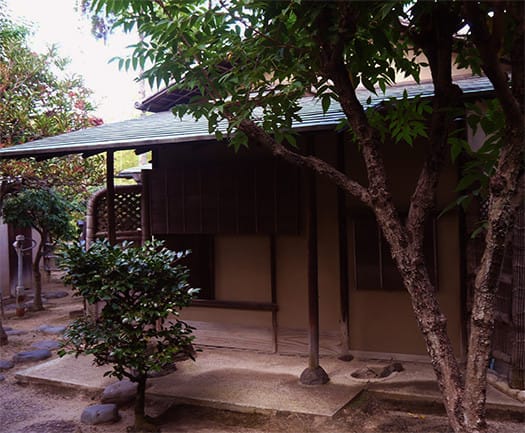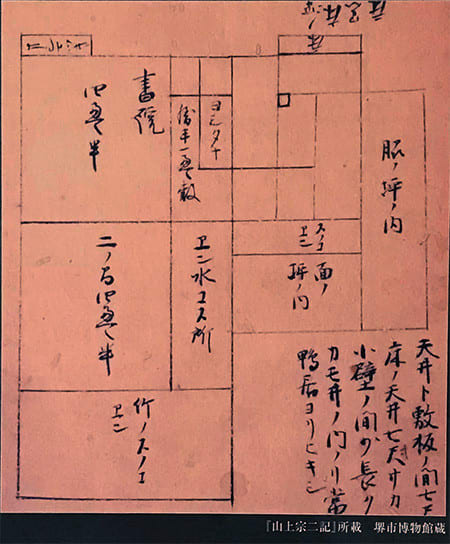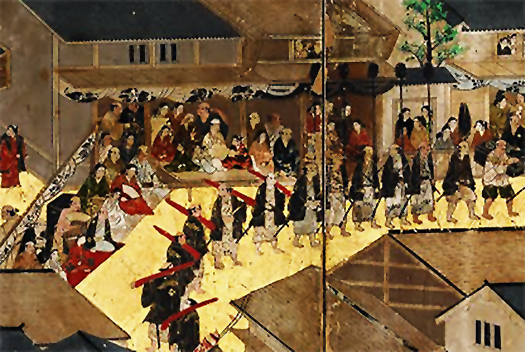


堺の町シリーズでやはり茶の湯に触れないわけにはいかないでしょうね。
市の博物館でも茶の湯のコーナーがかなりのスペースで設置されていた。
実際の茶室展示もありました。町のアイデンティティだとわかる。
わたしのブログでは最近、富山の廻船問屋住宅を取り上げたときに
番頭さんの居室が茶室になっていて、情報交流の機会になっていたことを
深掘りしてみていました。日本の商家と茶の湯というのは、やはり同根している。
茶という人間接触機会を捉えて文化にしようというのは、
やはり日本に特徴的なビジネス文化なのでしょうか。
そして茶の湯はそのための空間が建築として作られることで、
その文化性が住宅建築の世界に深く根を下ろしていって
いわば空間の「吟味」のためのひとつの基準になってすらいる。
作法だとか、伝統だとかの「約束事」を構成している。
堺と茶の湯ということで武野紹鴎さんという名前が出てくる。
堺の商人たちの人的ネットワークのなかでそのイデオローグ的な位置を占め
利休さんの師匠というような位置付けだとされる。
2枚目の写真はその武野さんの「真」の茶室思想表現だと。
真というのは、日本の中世以来の諸芸道での様式や空間の価値概念を表す理念語。
「真行草」の真がこのように規定されている。
四畳半という四角い空間とその畳の敷き方がまずあり、
そして各部位の仕様について但し書きが記されている。
「紹鴎四畳半図」として以下のような記述。
〜狭義には宋、元、明、清時代の美術作品を指す「唐物」を所有する
京や堺の有力商人たちが写し建てた茶室の設計平面図。
唐物を持たない侘数寄が平三畳の茶室を建てたことに対する「真」の茶室。
紹鴎の四畳半はヒノキの角柱に鳥の子紙の貼り付け壁で北向きの座敷。〜
「鳥の子紙」とは主に雁皮(がんぴ)を原料とし、光沢があり滑らかで
緻密な肌合を持った手漉きの和紙とされます。転じて手紙の紙が壁に貼られた。

真の四畳半は真四角の平面になる。
たぶん、そのように主客の対等性をあらわした上で、
床が上座、下座の結界表現になりやや上座側に炉が切られる。
対等な上でその場の役割の違いを明確化させたりしたのでしょう。
座談のときの座の規範を考えて行った空間規定だとわかる。
床の間に唐物(宝物品)や掛け軸などを展示して
結構なモノを鑑賞するというのが茶の湯の基本的な意味合いか。
禅の導入とほぼ同時期に茶が日本で栽培されるようになって
その鑑賞文化が接遇文化の深まりと同時に追究されていったものでしょう。
堺という商業都市で、商人たちの「腹を割った」話合いを
空間的に規範化して、ビジネスをより活性化したもののように思える。
とくに海外交易の畿内地域での主要港湾としては、
情報というモノの占める割合が非常に高くなっていったのでしょう。
とくに海外交易では情報の真贋性が強く問われ、建築にも「真」が求められたか。
その情報の希少性をより演出する文化装置として茶の湯、
茶室文化というものは発展する基盤を形成されたのか。
そういった消息が堺の町に来て実感できた思いがしておりました。
English version⬇
[Sakai Town Shu Chanoyu and Tea Ceremony Architecture Theory / Japanese Good House Special Edition ㊱-7]
You can't help but touch the tea ceremony in the Sakai Town series.
Even in the city museum, a tea ceremony corner was set up in a considerable space.
There was also an actual tea room exhibition. It turns out to be the identity of the town.
When I recently covered Toyama's shipping wholesaler housing on my blog
The fact that Mr. Banto's room was a tea room was an opportunity for information exchange.
I was digging deep. Japanese merchants and tea ceremony have the same roots.
To seize the opportunity of human contact called tea and make it a culture
Is it a business culture that is characteristic of Japan?
And the tea ceremony is created by creating a space for that purpose as an architecture.
Its cultural nature is deeply rooted in the world of residential architecture
So to speak, it has even become a standard for "examination" of space.
It constitutes a "promise" such as manners and traditions.
The name Takeno Jōo comes out because of Sakai and the tea ceremony.
Occupies its idealistic position in the human network of Sakai merchants
It is said to be positioned like Rikyu's master.
The second photo is Mr. Takeno's "true" tea room ideological expression.
True is a philosophical word that expresses the value concept of style and space in various arts since the Middle Ages in Japan.
The truth of "Shinkokusa" is defined in this way.
First of all, there is a square space of four and a half tatami mats and how to lay the tatami mats.
And a proviso is written about the specifications of each part.
The following description is given as "Takeno Jōhan Yojohan".
~ In a narrow sense, owns "Karamono", which refers to works of art from the Song, Yuan, Ming, and Qing dynasties.
A design plan of a tea room copied by leading merchants in Kyo and Sakai.
A "true" tea room for Wabi-sabi, who does not have karamono, built a tea room with 3 tatami mats.
Takeno's four and a half mats are a tatami room facing north with a wall of cypress prisms and torinokogami. ~
"Torinokogami" is mainly made from ganpi and is glossy and smooth.
It is said to be handmade Japanese paper with a fine texture. In turn, a piece of letter paper was stuck on the wall.
Both the true four and a half tatami mats and the three tatami mats of grass are square planes.
Perhaps, after expressing the equality of the main customer in that way
The floor is the boundary between the upper and lower seats, and the furnace is cut slightly to the upper seat side.
Perhaps they also clarified the difference in the roles of the place on an equal footing.
It can be seen that it is a spatial regulation that was made in consideration of the norms of the seat at the time of the roundtable discussion.
Displaying karamono (treasure goods) and hanging scrolls between the alcove
Is it the basic meaning of the tea ceremony to appreciate a good number of things?
Tea began to be cultivated in Japan at about the same time as the introduction of Zen.
The appreciation culture would have been pursued at the same time as the hospitality culture deepened.
In a commercial city called Sakai, talk about "hungry" merchants
It seems to have been spatially standardized to make the business more active.
Especially as a major port in the Kinai region for overseas trade
Perhaps the proportion of information as a thing has become extremely high.
Especially in overseas trade, the authenticity of information was strongly questioned, and was "true" required for architecture?
Tea ceremony as a cultural device that further enhances the rarity of that information
Did the tea room culture form the foundation for development?
I felt that I was able to feel that kind of news when I came to the town of Sakai.



















